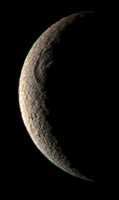Saturn V

Rhea (“REE a”) is the fourteenth of Saturn’s known satellites and the second largest:
orbit: 527,040 km from Saturn
diameter: 1530 km
mass: 2.49e21 kg
In Greek mythology Rhea was the sister and wife of Cronus (Saturn) and the mother of Demeter, Hades (Pluto), Hera, Hestia, Poseidon (Neptune), and Zeus (Jupiter).
Discovered by Cassini in 1672.
Though somewhat larger, Rhea is otherwise very similar to Dione. They both have similar compositions, albedo features and varied terrain. Both rotate synchronously and have dissimilar leading and trailing hemispheres.
Rhea is composed primarily of water ice with rock making up less than 1/3 of its mass.

The leading hemisphere is heavily cratered and uniformly bright (left). Like Callisto, the craters lack the high relief features seen on the Moon and Mercury.

On the trailing hemisphere there is a network of bright swaths on a dark background and few visible craters (right).
Rhea’s history is probably very similar to Dione’s.
More about Rhea
- more images
- Rhea from Satellites of the Outer Planets
- a bright new crater
Open Issues
- The surface features of Rhea and Dione seem almost identical yet Rhea is twice as massive. Why are they so similar?
